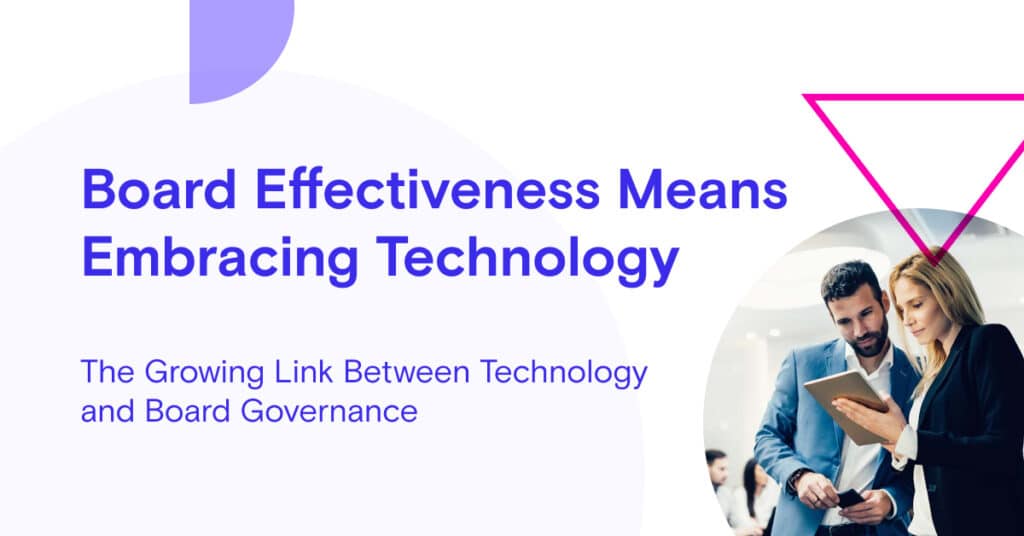
Boards that embrace the technology that helps them operate more efficiently, effectively, and securely operate better than boards that neglect those areas.
Something you know: 2020 was a time of fear, uncertainty, and upheaval.
Something you might not know: if you live in the United States, it was also our country’s most productive professional year ever, thanks to quick organizational pivots and a burgeoning digital economy.
No one wants to relive a global pandemic. But the question today is, how do we keep that spirit of successful innovation alive and well?
The evolution of technology has wide-ranging impacts, and for many companies, that evolution begins in the boardroom. From adopting new operational software to driving organization-wide digital transformation, succeeding as a board today requires embracing technology and looking forward.
During our ATLAS Leadership Series, technology pioneer and IBM Fellow Emeritus Nick Donofrio joined us to explain the mindset leaders can adopt to spur continuous improvement. A prolific board director, Nick recently published a memoir called “If Nothing Changes, Nothing Changes” about our ability to drive transformation within the realm of technology and beyond.
Here, we’re sharing key insights from our conversation with Nick on how boards can achieve success through technology, from instigating change to adopting board management software and having more efficient meetings.
1. Don’t Just Accept Change. Pioneer It.
First, we have to come to terms with a crucial fact: Nobody controls or determines the rate at which technology changes. The only certainty is that it will change, which means board members need to be proactive and adaptable.
“We as leaders have to become masters of change,” Nick says. “You have to embrace change, you have to harness it, and you have to, in some cases, cause it.”
When Nick joined IBM in 1964, the technology of the day was vacuum tubes. Today, it’s transistors, semiconductors, and large-scale integration. Watching technology develop so swiftly made Nick feel like he had whiplash. But his success in the industry came from facing those changes head-on.
Fortunately, you don’t need to be a technology expert to embrace and even initiate change.
“If you know it’s possible, then someone’s going to do it. That’s all you have to know. What you need to then say is, ‘OK, what do we need to do it?’” Nick says.
Learning how to help people within your organization accomplish new things is the best place to start.
2. Technology Is No Longer Owned by IT
When technology was less sophisticated, tech decisions typically existed solely within the purview of the IT department. Today, digital functions are embedded throughout organizational workflows.
Board members are an organization’s primary decision-makers. It makes sense that they should work to get comfortable with technology and have a say in where technology will take the company next.
According to McKinsey, boards need to start weighing in on technology strategy to succeed, but many still tiptoe along the periphery. As of March 2022, only 12% of global Fortune 500 companies have tech committees.
Hone Technology Expertise
Industries that rely heavily on technology and digital transformation to obtain a competitive advantage are typically among the first to prioritize efforts such as forming a technology committee.
No matter what industry they operate in, all boards should aim to follow technology best practices. This starts with asking the right questions and determining meaningful metrics and governance to track progress.
Other tips to unleash the full power of technology include:
- Pursue continuous technology education
- Hone internal technical expertise
- Engage with external technology leaders
When organizations take steps to assess the link between business success and technology, they unlock the ability to set clear goals for technological transformation — while simultaneously adding value and minimizing risk.
Meet Your Digitization Goals
Many boards of directors now recognize that digital business strategy is synonymous with business strategy in general. Because digital success has the potential for large-scale macro benefits, accountability for that success falls on the C-suite.
But the C-suite has been slow to recognize that. Eighty-nine percent of board directors say digital is embedded in business growth strategies, only 35% are on track to achieve their digital transformation goals.
Priming your organization for success means meeting those digital goals so you can place big bets and capitalize on new opportunities.
In a business landscape that’s home to increasing disruption, savvy boards focus on how they can benefit from that disruption instead of being set back. This can only happen when those at the top levels of the organization accept the critical role technology plays in driving success.
3. The Board Bears Responsibility for Change
An effective board can accomplish more for the organization it serves. Board decisions ultimately determine if an organization succeeds or fails.
Articulate the Need for Change
Boards of directors are among the primary decision-makers for emerging technology investments in over half of organizations. This means that board members are on the proverbial front lines and are thus among the best equipped to promote change.
“You as a leader have got to be able to articulate the need for change,” Nick says.
This starts with understanding the problem. Ask yourself and your team:
“What is the compelling nature of the problem we’re trying to solve?”
If you can’t start with the problem, you’re going to have a hell of a time trying to get anybody to move,” Nick says.
Good leaders understand the problem, show their team they recognize the problem, and are open-minded to new, digital solutions to solve the problem.
Get to the ‘Why’
The biggest mistake most business leaders make is focusing exclusively on results. According to Nick, it is equally important to focus on the “why” and “how” behind those results.
“If I’m going to be held accountable and I’m the last person to be fired, I need to understand what you do, why you do it, and how you do it — not just what you do,“ Nick says. “As a board member, in the end, you are the last person responsible.”
Those questions begin in the boardroom itself, which is why it’s critical to increase board efficiency with tools like effective agendas that let board members skip administrative bloat and zero in on key topics that offer strategic leverage.
Ensure Board Continuity
It’s increasingly clear that change — including board turnover — is inevitable.
An often-overlooked key to success is ensuring that all board members have access to information that illuminates current business priorities and historical decision-making.
Despite internal and external changes, boards must ensure continuity. Strategic board management software helps by offering members a single, centralized portal to consume content on demand.
4. Focus on Security in 2023
While technology changes pose significant opportunities and risks, perhaps the biggest risk is the threat posed to the security of your company’s data.
Think Beyond Cybersecurity
Nick says that while cybersecurity is the buzzword du jour, it’s important to pursue a more holistic vision of data security.
“Data risk is the first risk,” Nick says. “If you’re going to build your business off AI, if you’re going to build your business off data, you better have control and ownership of all the data that you are using. And if you can’t, it’s only a matter of time before it’s going to take you out.”
The need to secure data is exactly why the fight for better technology and productivity is so important. Technology provides both an opportunity and an incentive to change faster and for the better.
Calculate the Cost of a Breach
The average cost of a data breach in 2021 was a cool $4.24 million. That number represents a 10% increase from the previous year.
If you take steps to increase your board security in 2023, those actions could mean the difference between secure board communications and board communications that are in jeopardy.
Board meeting software offers a simple route to centralize and secure your board’s data.
A central hub allows all resources, documentation, meeting minutes, agendas, and bylaws to live together in a central and safe place — without wasting precious minutes or hours searching through unsecured email threads and text messages.
One central portal means you have more security at the front end of that platform and less vulnerability due to having fewer channels that are susceptible to a cyberattack.
5. Board Software Improves Effectiveness and Security
Remote and hybrid meetings are here to stay, and new ways of operating require new digital solutions. Our 2022 board effectiveness survey of over 400 global board leaders shows that board technology improves board operations by boosting confidence and efficiency.
When it comes to technology, the 57% of respondents who currently use board technology said:
- 63% said their board was more collaborative in the last 12 months
- 69% of respondents said their board was more effective in the last 12 months
- 85% are confident in board communications security today
Make More Time for What Matters
How exactly does board software correlate to effectiveness? Board meetings aren’t frequent, but they typically last for hours. More efficient meetings means boards can address strategic objectives more quickly and more in-depth.
When you put tools like OnBoard’s Agenda Builder and Minutes Builder to work, you quickly replace clunky PDFs with digital counterparts that are easy to update in real time and upload to your board portal.
By shifting administrative tasks and document review to the pre-meeting realm, you make more space during meeting time for board members to tackle the meaty and essential matters that reap results.
Enable Continuous Feedback and Improvement
If the main reason to embrace technology is to unlock continuous improvement for your organization, that philosophy should begin with the board itself.
One of OnBoard’s newest portal features is Meeting Feedback, which lets boards create a continuous feedback loop to help improve meetings. Another new feature, Board Assessments, allows boards to gather anonymous, honest feedback from members.
They can then address internal feedback quickly to make operational shifts that optimize the board moving forward.
Productivity Breeds Better Results
Boards have a critical leadership role in the organizations they serve. In today’s world, helping the organization succeed hinges on embracing change, leveraging technology in smart ways, and continuously improving in ways that enhance productivity.
“OnBoard sells you a productivity tool. That is productivity technology that you have to learn to understand, embrace, and fully take advantage of. More of that needs to be done,” Nick says.
When boards take steps to become more effective and secure themselves, they make the overall organization more effective and secure.
If in doubt, start by solving one problem at a time. Keep your board agendas streamlined, and focus your board’s effort on issues that matter. When you do that, greater effectiveness in 2023 is within reach.
For more information on the top trends facing boards today, watch the videos in our ATLAS Leadership Series.
Want to fuel your startup for success? Get started with a free trial of OnBoard.
About The Author

- Adam Wire
- Adam Wire is a Content Marketing Manager at OnBoard who joined the company in 2021. A Ball State University graduate, Adam worked in various content marketing roles at Angi, USA Football, and Adult & Child Health following a 12-year career in newspapers. His favorite part of the job is problem-solving and helping teammates achieve their goals. He lives in Indianapolis with his wife and two dogs. He’s an avid sports fan and foodie who also enjoys lawn and yard work and running.
Latest entries
 Board Management SoftwareApril 23, 2024How to Form a Crisis Response Team (Step-by-Step)
Board Management SoftwareApril 23, 2024How to Form a Crisis Response Team (Step-by-Step) Board Management SoftwareApril 12, 2024Board of Directors Compliance Training: 5 Best Programs
Board Management SoftwareApril 12, 2024Board of Directors Compliance Training: 5 Best Programs Board Management SoftwareApril 10, 20245 Best Compliance Training Programs
Board Management SoftwareApril 10, 20245 Best Compliance Training Programs Board Management SoftwareMarch 28, 20245 Advantages of an Initial Public Offering
Board Management SoftwareMarch 28, 20245 Advantages of an Initial Public Offering



